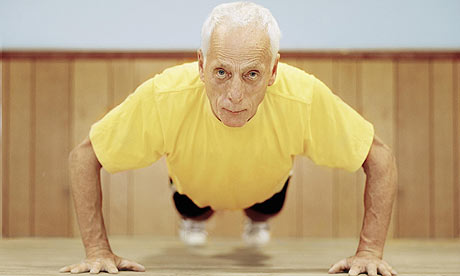
Build Muscle and Change Your Body at ANY AGE!
November 10, 2012 // Fitness, Wellness
Many individuals assume an increase in age equates to a decline in health and wellness. Contrary to popular belief, building lean tissue and improving health is possible at any age. The human body adapts to its environment and can always be improved. A well-structured diet and exercise routine can significantly reduce muscle loss and risk of diseases. Many gym communities are growing as the older population (+55 years old) understands these important concepts.
Changes in Metabolism
The human body is built upon simultaneous internal functions that work together to keep the body alive and adapted to its environment. These system functions require energy (measured as Calories) to operate. The total amount of energy required for each of our physiological actions is referred to as the metabolism. The metabolism is categorized by five metabolic components:
1. Basal Metabolic Rate (BMR)
The minimum level of energy expenditure needed to maintain vital functions of the body while awake.
2. Resting Metabolic Rate (RMR)
The minimum level of energy expenditure needed to maintain vital functions of the body while at rest.
3. Thermic Effect of Feeding (TEF)
The energy required for digestion, absorption and assimilation of ingested food/nutrients.
4. Exercise Activity
The energy used to perform purposeful exercise.
5. Non-Exercise Activity Thermogenesis (NEAT)
The energy used for unplanned, low intensity physical activity that takes place everyday.
Research shows that on average, individuals experience a 2-4% decline in their resting metabolic rate (RMR) with each passing decade after the age of 25.
Example:
(kcal = Calorie)
At age 25, you have an RMR of 1500 kcal.
At age 35, you will have an RMR of 1400 kcal.
At age 45, you will have an RMR of 1300 kcal.
At age 55, you will have an RMR of 1200 kcal.
At age 65, you will have an RMR of 1100 kcal.
At age 75, you will have an RMR of 1000 kcal.
Because your RMR decreases every decade past age 25, your food intake should also decrease to keep your body at an ideal weight, shape, and condition.
Muscle Loss
Metabolic loss also causes muscle loss. On average, people lose about 5 lbs of lean mass (muscle) per decade between the ages of 25 and 65. So, in addition to reducing around 300 kcals of metabolic function by the age of 65, individuals lose about 20 lbs of lean mass. Because muscle is so metabolically active, this muscle loss is probably directly responsible for much of the metabolic losses. This correlation suggests that metabolic decline is not age-related; Rather, it’s lifestyle-related. What people think as “normal” aging may, in fact, be an outcome of inactivity. If people take steps to preserve their muscle mass with age, they’ll also preserve their RMR to a large extent. This is why muscle contraction and intensity are such important factors for the preservation of the human body.
Formula for Muscle Loss and Metabolic Decline:
Less Activity » Loss of Lean Mass » Reduction of RMR » Weight Gain » Declining Health Profile

Formula for Muscle and Metabolic Preservation:
Increased/Continued Activity » Increase Lean Mass » High RMR » Weight Maintenance » Ideal Health Profile
Real Life Example: The Fittest Nonagenarian on the Planet
Let’s use the story of Charles Eugster to show the effects of continuos physical activity and healthy habits.

Charles Eugster
At age 91, Charles Eugster claims that he is the “fittest nonagenarian on the planet.” His impressive physique is a testament to his regular resistance-training and cardiovascular workouts. Charles trains his muscular system 3 times a week with weights and his cardiovascular system twice a week with rowing workouts. Besides preserving and building lean muscle tissue, Charles also boasts an ideal health profile:
- Absence of any age-related diseases
- Low LDL and High HDL cholesterol levels
- Resting Heart Rate around 50 bpm (beats per minute)
- Above average levels of testosterone